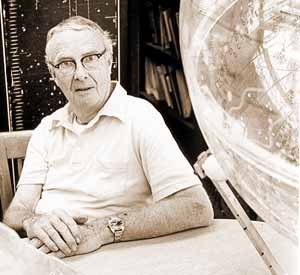|
|
 |
 |

NOBEL LAUREATE LUIS ALVAREZ, WHO DIED IN 1988
|
"You might say that Iím practicing geology without a license,"
laughs Lawrence Berkeley Laboratoryís Luis Alvarez, referring to his
part in the study of geological sediments and the great extinctions. The
project is one in a long line of exotic research projects which Alvarez
has initiated over the years. Alvarez is an experimental physicist in the
classical sense; he is interested in everything under the sun -- and
beyond. Thatís not to suggest he has neglected the field of elementary
particle physics. He won the Nobel Prize in 1968 for the development of
the hydrogen bubble chamber and the discovery of new resonance states.
Alvarezís wide-ranging interests are evident everywhere when you
enter his office at the Lab. On the table is a model of a pyramid
constructed some 13 years ago when he and a team from LBL searched the
pyramid of Cephren at Giza for hidden chambers, using cosmic rays as the
probe. Behind the pyramid is a large, plastic three-dimensional star map,
evidence of his involvement in astrophysics.
Alvarez often uses the phrase, "it occurred to me," to
describe how an idea came to him. Unlike Agatha Christie, who lay in the
bathtub eating apples when she wanted to solve a problem, Alvarez says
ideas occur to him anywhere. Some of his most creative thinking about the
structure of the pyramids came to him when he was on an expedition in
Antarctica, flying over the vast, white wasteland of ice and snow. He
thought of a solution to the problem of how to stabilize a hand-held movie
camera in a hotel room in Nairobi. His image stabilizer, which fits in
with the optical components of a camera, has been patented and now belongs
to Bell and Howell.
"I donít usually verbalize my ideas first; my thoughts are
entirely in the form of visual images," explains Alvarez. His
interest in optics is a natural tangent for a visual-minded thinker, if
youíre Luis Alvarez, that is. His invention of the variable focus lens,
used by optometrists, is being developed and manufactured by a local
company which he started with some former associates at LBL.
Though Alvarez "doesnít suffer fools gladly," he
appreciates mistakes; in fact, he capitalizes on them. "If I had
known the iridium work had been done earlier (by Barker and Anders in
1968) and the iridium was not useful for what I had in mind, I wouldnít
have found the iridium spike, which we think may be related to the
extinction of half the life forms on earth sixty-five million years
ago."
Itís called serendipity -- "a faculty for finding valuable
things not sought after."
ó By Phila W. Rogers
Additional Information:
|


